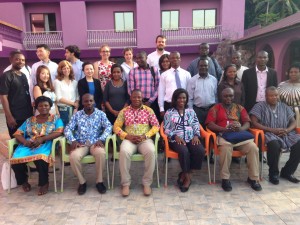Preparing for the Launch of Ghana’s Community Health Worker Program in the Ashanti Region

Following the Campaign’s South-South Collaboration Workshop in Accra, the team packed their bags and hopped on a short flight from Accra to Kumasi, one of the largest metropolitan areas in Ghana. Kumasi is the central hub of the Ashanti Region, where the Campaign is supporting the Ghana Health Service (GHS) to recruit, train, equip and deploy up to 1,800 Community Health Workers (CHWs). We were thrilled to meet with the Ashanti Regional Health Management Team (RHMT), led by Dr. Alexis Nang-Beifubah, GHS Program Managers and Regional Research Officers, NGO partners, and District Health Directors from the six districts where the CHW program will be piloted this year. These individuals have formed a CHW Program Technical Working Group (TWG) for the Ashanti Region, which will oversee implementation of the program.
Ghana’s CHW program has been designed to strengthen the national Community-based Health Planning and Services (CHPS) program, which aims to make health care accessible in communities across Ghana. CHWs will work alongside trained nurses, or community health officers (CHOs), to conduct home visits, improve community-based disease surveillance, and strengthen community engagement and health promotion – all vital components of the CHPS strategy.
With the goal of developing a comprehensive implementation plan for the CHW program, the Campaign team worked with the Ashanti TWG to conduct a situational analysis of CHPS operations in the six pilot districts. The goal of the situational analysis was to understand the processes required to start-up and maintain CHPS operations over time. The exercise broke down CHW and CHPS operations into eight core components:
- Financing
- Human resource management
- Training
- Supervision
- Supply chain management
- Community engagement
- Referrals
- Monitoring and evaluation
During the meeting, we systematically gathered information from the TWG to understand how each process is implemented and maintained, who is responsible, and what gaps, challenges, and inefficiencies exist. We used this information to discuss how existing processes can be utilized and/or adjusted upon introduction of CHWs into the health system.
Our Systems Implementation Advisor, Anne Liu, also led the TWG through a “RACI” matrix exercise. RACI – which stands for Responsible, Assist, Consulted and Informed – is a helpful exercise to identify the roles of different stakeholders in starting up and maintaining a program. This activity led to some very interesting discussions among TWG members. It became apparent that achieving consensus on who was responsible for what is often difficult.
The failure to explicitly clarify roles and responsibilities is often what leads to implementation failure. So it is critical to have these types of conversations among different levels of governance – from regional to district and sub-district health teams –as a first step to ensuring that implementation is well coordinated, timely, and effective.
The Campaign team is looking forward to returning to Ghana for Part II of the implementation planning process this fall. During this time, we will work with the TWG to finalize CHW operational processes and responsibilities. The goal? A comprehensive implementation plan to ensure successful deployment of Ashanti’s CHW program pilot.
Stay tuned for more updates on our work in Ghana!
